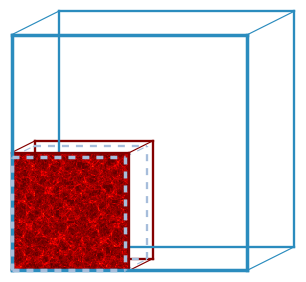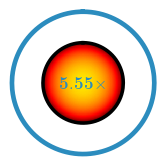Data Guide | Bolshoi (Planck)
This simulation is good for ...
- Modelling galaxies with stellar mass above ~10^7.5 Msun
- Probing scales up to 250 h^-1 Mpc (without repetition)
- Resolving small structures with high time resolution
Overview
The Bolshoi (Planck) simulation follows the particle number and volume of the Bolshoi simulation, but has a more up-to-date set of cosmological parameters, based on the Planck satellite data. The simulation was run with the Adaptive Refinement Tree (ART) code. The simulation is part of the MultiDark family of simulations described in Klypin et al. (2016).
Relative size
- Box length: 250 h^-1 Mpc
The volume relative to Millennium and an all-sky survey out to z=0.05:

Mass resolution
- Particle mass: 1.55 × 10^8 h^-1 Msun
- Gravitational softening: 1 h^-1 kpc
- Number of particles: 2048^3
- Number of snapshots to z=0: 178
The particle size compared to Millennium:

Bolshoi (Planck) has 5.55 times higher mass resolution than Millennium, meaning a Bolshoi (Planck) halo contains 5.55 times the number of particles of a Millennium halo of equivalent mass
Cosmology
The cosmological parameters of the Bolshoi (Planck) simulation are based on Planck data released in 2013 (published as Planck Collaboration XVI 2014).
- Ω_M = 0.307
- Ω_Λ = 0.693
- Ω_b = 0.048
- σ_8 = 0.823
- n = 0.96
- h = 0.678
Haloes
Haloes and subhaloes were identified using ROCKSTAR, with merger trees subsequently built with CONSISTENT-TREES. Where other codes might only use the positions of particles to build haloes, ROCKSTAR uses the velocities of particles as well. The trees follow all (sub)haloes down to as few as 2 particles.